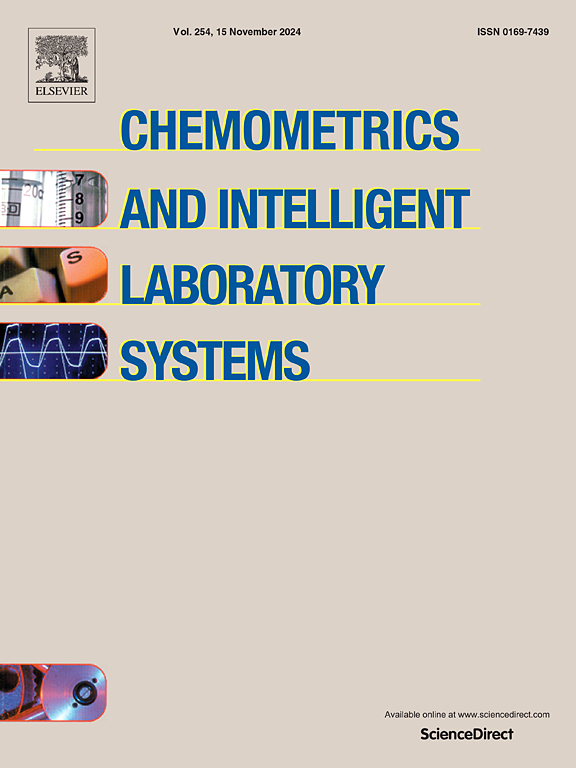用化学计量学增强白蛋白检测:基于溴甲酚绿的比色传感器开发的多变量方法
IF 3.7
2区 化学
Q2 AUTOMATION & CONTROL SYSTEMS
Chemometrics and Intelligent Laboratory Systems
Pub Date : 2025-04-08
DOI:10.1016/j.chemolab.2025.105400
引用次数: 0
摘要
尿中人血清白蛋白(HSA)的检测对于肾病综合征和糖尿病肾病的早期诊断至关重要。在本研究中,我们开发了一种基于溴甲酚绿(BCG)吸附在捕色器®(CC)薄片上的具有成本效益的比色传感器,用于白蛋白检测。该传感器在酸性pH值下与白蛋白相互作用时,会发生从黄色到蓝色的可见颜色变化,从而实现定性检测。采用实验设计(DoE)方法优化传感器的制备和应用,并控制实验室规模制备过程中的实验变异性,确保提高灵敏度和鲁棒性。几个多变量数据分析工具,包括主成分分析(PCA)和判别分析(LDA和QDA),被合并来描述样本,建立鲁棒性和预测性模型,并评估检测性能。经过优化的传感器对白蛋白的检测限低至0.5 μM,使其成为快速、低成本、用户友好的护理点(PoC)应用的有希望的候选者。本文章由计算机程序翻译,如有差异,请以英文原文为准。
Enhancing Albumin Detection with Chemometrics: A Multivariate Approach to Bromocresol Green-based Colorimetric Sensor Development
The detection of human serum albumin (HSA) in urine is crucial for the early diagnosis of nephrotic syndromes and diabetic nephropathy. In this study, we developed a cost-effective, colorimetric sensor based on Bromocresol Green (BCG) sorbed on Color Catcher® (CC) sheets for albumin detection. The sensor undergoes a visible color change from yellow to blue upon interaction with albumin at acidic pH, enabling qualitative detection. A Design of Experiment (DoE) approach was applied to optimize sensor preparation and application and to control experimental variability within the lab-scale preparation procedure, ensuring enhanced sensitivity and robustness. Several multivariate data analysis tools, including Principal Component Analysis (PCA) and Discriminant Analysis (LDA and QDA), were merged to describe the samples, develop robust and predictive models and assess detection performance. The optimized sensor proved a detection limit as low as 0.5 μM for albumin, making it a promising candidate for rapid, low-cost, and user-friendly point-of-care (PoC) applications.
求助全文
通过发布文献求助,成功后即可免费获取论文全文。
去求助
来源期刊
CiteScore
7.50
自引率
7.70%
发文量
169
审稿时长
3.4 months
期刊介绍:
Chemometrics and Intelligent Laboratory Systems publishes original research papers, short communications, reviews, tutorials and Original Software Publications reporting on development of novel statistical, mathematical, or computer techniques in Chemistry and related disciplines.
Chemometrics is the chemical discipline that uses mathematical and statistical methods to design or select optimal procedures and experiments, and to provide maximum chemical information by analysing chemical data.
The journal deals with the following topics:
1) Development of new statistical, mathematical and chemometrical methods for Chemistry and related fields (Environmental Chemistry, Biochemistry, Toxicology, System Biology, -Omics, etc.)
2) Novel applications of chemometrics to all branches of Chemistry and related fields (typical domains of interest are: process data analysis, experimental design, data mining, signal processing, supervised modelling, decision making, robust statistics, mixture analysis, multivariate calibration etc.) Routine applications of established chemometrical techniques will not be considered.
3) Development of new software that provides novel tools or truly advances the use of chemometrical methods.
4) Well characterized data sets to test performance for the new methods and software.
The journal complies with International Committee of Medical Journal Editors'' Uniform requirements for manuscripts.

 求助内容:
求助内容: 应助结果提醒方式:
应助结果提醒方式:


